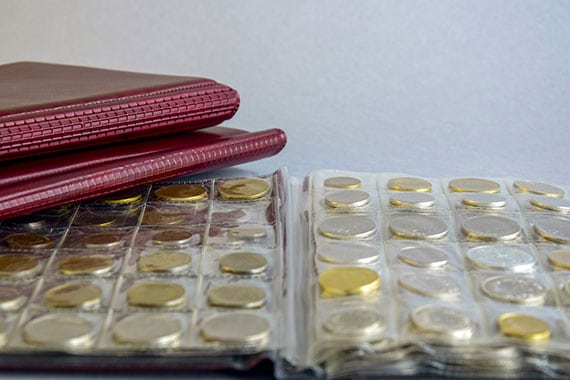U.S. Coins

Coins have been a form of currency through the ages, so it’s no surprise that coin collecting has long been a pastime for many different people. If you have a collection of U.S. coins—or even just a few rare coins you’d like to grow into a larger collection — Arizona Stamp & Coin is your local resource for buying and selling U.S. coins, appraisals, and collectors’ tips. In addition to an amazing selection of United States coins, we offer a wide selection of paper currency, international coins, and privately minted coins.
Collecting U.S. Coins: The Basics
If you’re just starting a coin collection, you’ll want to know a few basics about what makes some coins more valuable than others. You should also invest in materials to store and care for your collection, which you can find in our store.
- Coin Anatomy – Coins may be considered collectables for a variety of reasons. Some are error coins with unique defects from the minting process. Others are special issue commemorative coins that have never gone into circulation, and some are highly limited issues from the United States mint. When you’re looking at a coin, there are a few key terms you should know.
- Obverse – The head’s side of the coin.
- Reverse – The tail’s side of the coin.
- Edge – The outer border of the coin, may be flat, ridged, lettered, or decorated.
- Rim – The raised section on both sides of the coin, which helps protect the coin’s design.
- Mint Mark – A letter or symbol noting where the coin was minted. In the U.S. mint marks are currently Philadelphia (P), Denver (D), San Francisco (S), and West Point (W).
- Relief – Design elements raised above the surface of the coin.
- Field – Flat coin surface that’s not raised and has no inscription.
- Caring for Your Collection – You might think coins are durable because they’re made of metal, but they can be quite delicate when handled due to the natural oils in our skin. Therefore, it’s important to wear gloves when handling your coins. In addition, you’ll want to keep a few tools on hand to view and sort your collection: a magnifying glass, plastic ruler, soft cloth, coin holders or albums for storage, and good lighting. Coins should be stored in a cool, dry area without extreme temperature fluctuations.
Coin Appraisal
Coins are valued based on a wide range of factors, including grading systems from organizations like NGC, ANA, and PCGS. The Sheldon coin grading scale is commonly utilized, and this scale accounts for how well the coin was made, how much wear it’s developed, and the luster of the coin. When you bring in coins for appraisal, we’ll consider these factors as well as the numismatic value, mintage and rarity, and associated paperwork or certification materials. In most cases, collections that are well cared for and show minimal signs of damage and handling will carry the highest value.
While there are many high-value coins out there, you might consider keeping an eye out for these rare U.S. coins that can boost the worth of your collection.
- 1943 Lincoln Steel Cent
- 1864 Two Cents
- 1883 “No Cents” Liberty Nickel
- 1938-D Walking Liberty Half Dollar
- 1964 Kennedy Half Dollar
- 1916-D Mercury Dime
- 1876 Liberty Seated Half Dollar
- 1979 Susan B. Anthony Dollar

Buy and Sell Coins at Arizona Stamp & Coin
If you’re seeking an appraisal for your collection because you want to sell or pawn your rare coins, you can count on Arizona Stamp & Coin to offer a competitive price. For coins that don’t have a high collector’s value, we can offer a pawn loan or sales offer based solely on the precious metal content of your gold, silver, or platinum coins.